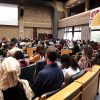Sunday, May 12, 2024
News and Views from the Global South
Opinion
“AND WE ALL THOUGHT THAT BANKS HAD MONEY!”
This column is available for visitors to the IPS website only for reading. Reproduction in print or electronic media is prohibited. Media interested in republishing may contact romacol@ips.org.
- The latest moves by governments and central banks around the world to inject massive new money into their banks leaves average citizens outraged and mystified. Weren\’t banks the places that guarded our deposits and then lent them out to borrowers to help build our communities and grow our businesses? We were told to trust banks. Now we learn that banks don\’t trust each other, writes Hazel Henderson, author of Ethical Markets: Growing The Green Economy (2007) and co-creator with the Calvert Group of the Calvert-Henderson Quality of Life Indicators. In this analysis, Henderson writes that the global casino of finance has long required international regulatory agreements and oversight. We learn at last that such agreements will be sought at a new Bretton Woods-type global summit. Today, once again, taxpayers in the US, Europe, and Asia are being forced to re-capitalise their banks. This is now revealed as the reverse of what economists have led us to believe. Instead, we see that banks have always received money from taxpayers via governments\’ central banks in order to lend it back to taxpayers at interest.
Yet trust, the vital factor of productive societies and markets, is ignored in economists’ calculations.
No wonder the shocking revelations about Wall Street’s mis-doings, encouraged by de-regulation and lack of oversight, led to a loss of confidence. Their reckless leveraging and collusion with predatory mortgage lenders in the US are leading many to question the fundamental way our banking and money-systems are designed. Banking panics have been regular occurrences over the past century, and it has always been taxpayers through their governments that have bailed out the bankers’ foolish mistakes.
The global casino of finance has long required international regulatory agreements and oversight. We learn at last that such agreements will be sought at a new Bretton Woods-type global summit. Today, once again, taxpayers in the US, Europe, and Asia are being forced to re-capitalise their banks. This is now revealed as the reverse of what economists have led us to believe. Instead, we see that banks have always received money from taxpayers via governments’ central banks in order to lend it back to taxpayers at interest.
How could we have all permitted such a scam to go on for so long? Instead of that simple story that banks take our deposits and then lend them out to credit-worthy borrowers, we see the truth, spelled out in the cartoon video “Money As Debt” at www.ethicalmarkets.tv. We can understand how the US became the world’s largest debtor nation.
In the US, Ron Paul, a congressman from Texas, ran for President of the United States to try to inform US citizens on how our central bank, the Federal Reserve Board, really operates. While we don’t agree with many of Paul’s prescriptions, he is essentially correct about the Fed and our banking system. The Fed is actually a private corporation run by its 12 reserve bank Districts, with only the Board members and chair appointed by the government. The Fed lends our money, created by the Treasury, to the banks which are then allowed to lend out ten times their monetary reserves to borrowers -this is known as the “fractional reserve banking system”. Banks have been required to keep 8 percent of their assets in reserve but lobbied incessantly to reduce this cushion against losses.
The banks simply create most of our money supply by making loans, and with the stroke of a pen, crediting the borrower’s account with the amount of the loan. They also charge the borrower interest on the loan – but omit to create the additional amount to be paid as interest. The US Constitution gives Congress -not private banks- the power to coin the nation’s money. Now that Congress, the Fed, and Treasury are again creating money directly to dole out to banks it is time to revert to the US Constitution.
Ever since 1913 when the Fed was created, Congress has turned its constitutional power to create our money supply over to the banking system and its lobbyists. Today, we see hidden in plain sight how this works. When the banks get in trouble, take stupid risks, etc., the Fed simply prints more money and gives it to them. This monetary arrangement was taught by the Chicago School founder, Milton Friedman, even if new money must be thrown from helicopters, as his student “helicopter Ben” Bernanke has been doing. If this isn’t sufficient, the Fed then adds more interest rate cuts, special lending through its Discount Window, and bailouts amounting to some USD 1 trillion, as well as Treasury Secretary Henry Paulson’s USD 700 billion plan.
Paulson originally wanted taxpayers to turn the USD 700 billion over to his former colleagues at Goldman Sachs, Morgan Stanley, and other Wall Street “money managers” to buy up the toxic assets created by mortgage lenders and the same Wall Streeters. Thankfully, Congress created some safeguards, and USD 250 billion will now go directly to buy stock in the banks and many alternative plans have been incorporated (Alternative Trickle-up Plans Beyond Paulson, Hazel Henderson, Oct. 2008). Since so many top staff, including Paulson, are former Goldman Sachs executives, taxpayers should insist that Goldman Sachs and Morgan Stanley, whose team advised the Treasury on the bailout, and other firms involved should be precluded from managing any of the USD 700 billion of taxpayers’ money. Instead, Paulson announced that a 35-year old former Goldman Sachs employee, Neel Kashkari (say ‘cash-carry’), will be in charge of contracting out our USD 700 billion to the “money managers.” You can’t make this stuff up!
For long-overdue reform of monetary systems, there are well-thought out proposals: in the US by the American Monetary Institute (www.monetary.org ); in Britain by banking expert James Robertson at www.jamesrobertson.com; and in Canada at www.comer.org.
At last the time has come to regulate Wall Street and the global casino, so as to return finance to its limited role in serving the needs of real, productive economies. Implementing these and other reforms can also make the banks fulfil their original purpose. They can finance maintenance of neglected public infrastructure and complement the private investments now pouring into the growing green economy, as all countries shift from the early fossil fuelled Industrial Age to the sustainable Solar Age. (END/COPYRIGHT IPS)

 Print
Print



